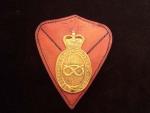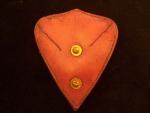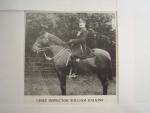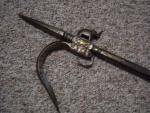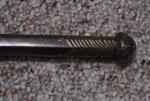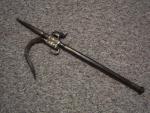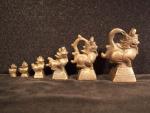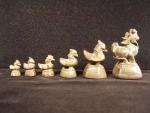-
Posts
6,486 -
Joined
-
Last visited
-
Days Won
10
Content Type
Profiles
Forums
Blogs
Gallery
Events
Store
Everything posted by Brian Wolfe
-
The Horse Martingale Badge. A martingale is a term used to describe several different types of tack (equipment and accessories worn by horses) used to control a horse's head. Primarily it prevents the horse from throwing its head so high as to strike the rider in the face. The martingale badge shown below was used by the Staffordshire County Police - Mounted Branch. These are becoming quite scarce and this one, being mounted on the original leather tack, even more so, in my opinion. I have only seen three styles of these badges used by the Staffordshire Police, 1. Victorian, to the Staffordshire Constabulary, which actually predates the official founding of the Mounted Branch (1919). 2. King's crown to the Staffordshire County Police. 3. Queen's crown also to the Staffordshire COunty Police, which is the one shown here.
-
Staffordshire Police - Mounted Branch 1919 - 2000 Staffordshire's Mounted Branch was founded in 1919 under Inspector William Dalkins, who would later be promoted to the rank of Chief Inspector. Fifty horses were obtained from the military with 25 stationed at Headquarters and the rest distributed to Divisional Stations around the county. Mounted officers wore the letter "M" pre-fix to their collar numbers and all horses were given names that started with the letter "S". By 1929 the number of horses had been reduced to 22 with West Bromwich being the only Divisional Detachment maintaining a Mounted Branch. With the increase in vehicular traffic and motorized patrols the Mounted Branch found new uses in crowd control and search and patrol work over large areas of land that was too rough for motorized vehicles. Despite this useful niche the Branch was disbanded in April 2000.
-
Ah, the voice of youth. Check my profile, there's a reason I have no hair. Too many battles lost! Regards Brian
-

pre WW1 three place medal bar
Brian Wolfe replied to Noor's topic in Great Britain: Orders, Gallantry, Campaign Medals
Nice trio Timo, I'd leave it as is but as we have said this many times, it's all a matter of opinion. Regards Brian -
I will add a nine year if a twenty exists as you know for sure it should be there. These are easy enough to find unnamed and since unnamed medals within groups are common enough I see no problem. However, when it is the 20 year that "seems" to be missing I alway err on the side of caution and never add it. Please do post the group when you have it mounted, I would be very interested in seeing it. Regards Brian
-
I would say that the probability is that he should have had a 20 year. Perhaps he never got aroung to having it mounted. If the mount is complete then I'd say that was all he bothered with, for whatever reason. The Op Vijay was to be named on the edge, however, I've not had any that were engraved so it seems to me that over the years the Indian Government has gotten a bit hit and miss in following through with the regulations and has issued them unnamed. In case you are thinking about remounting the group with the 20 year L.S.G.C. medal I would not recommend it as the group you have is original. That's just my opinion and I know you didn't ask, but I threw it in for the same price anyway. Regards Brian
-
Hello Everyone, For quite a while now I have been going to write a short history of the Staffordshire Police and feature specimens from my collection. I have finally gotten around to this and here it is. I started to collect to the Staffordshire Police quite by chance when a fellow collector, Jeff Cowdell, and then serving member of the Staffordshire Police sent me a Staffordshire custodian helmet. Jeff had no idea that he would also kindle an interest in British Police headgear and while I'm not sure my wife has yet forgiven him I have him to thank for an interesting collecting journey. I must also thank (blame) our fellow GMIC members, Mervyn Mitton and Stuart Bates for my addiction. STAFFORDSHIRE POLICE The foundations for the Staffordshire Police were laid in October of 1842 when it was decided at the Court of Quarter Sessions at Stafford that a Chief Constable should be appointed for a County Constabulary. This Constabulary was divided into three districts. 1. A mining district in the south of the county which would include the towns of Bilston, Willenhall, West Bromwich, Wednesbury, Smithwick and Handsworth. The South Staffordshire Constabulary had been formed in 1840 to police the above area but was amalgamated with the new force. 2. A pottery district in the North including the six pottery towns of Tunstall, Burslem, HAnely, Stoke, Fenton and Longton. 3. An area known as the Rural District took the remaining areas of the county. This excluded the four towns which already had police forces: Stafford, Newcastle-under-Lyme, Walsall and Tamworth. The first Chief Constable, Mr. John Hayes Hatton, 1842 - 1857, was appointed on 6 December 1842. He was 47 years old and a professional policeman. The uniform was originally a swallow tail coat and top hat which was replaced in the mid 1860s by a frock coat and kepi for daytime duties. A helmet was worn at night and in wet weather conditions. Other police forces preferred the helmet for all occasions. In 1894 the Chief Constable of the time, Captain the Honourable George Agustus Anson R.A.,C.B.E., M.V.O., D.L. (appointed in 1888) established the first detective branch for the force. These plain cloths officers were known as Enquiry Officers. The First World War brought with it a need for manpower to fill the vacancies created by officers leaving the force to enlist in the armed forces. All leave was cancelled for the duration and men were not allowed to retire. The Police Reserve, consisting of men who had recently retired, was called into active duty and the Special Constabulary was formed. The Police Reserve served in a full-time capacity while the "Specials" were a part-time force. The Special Constabulary was maintained after the War to provide support to the regular police officers. The Second World War again saw a need for replacement officers and the Police Reserve and the Special Constabulary stepped up to fill the void left by the officers enlisting in the armed forces. After WWII the Police Reserve was disbanded, however, the Special Constabulary continued to serve. The Mounted Branch was established in 1919 under Chief Inspector William Dalkins. The Mounted Branch served until 2000 when it was disbanded. I'll discuss the Mounted Branch in more detail later on in the post after a new item for the collection arrives. The Motor Transport and Patrol Branch was formed in 1930 under Chief Constable Colonel Sir Herbert Hunter, Kt., C.B., C.B.E., K.P.M. 1929 - 1951. This was followed by the introduction of motor cycles in 1960 for Traffic Patrol. This was either under Chief Constable Colonel George Hern, C.B.E., O.St.J, K.P.M., D.L. 1951 - 1960 or Chief Constable Mr. Stanley Peck, C.B.E., O.St.J.,B.E.M.,Q.P.M.,D.L. 1960 - 1964. More reserch will be required on this point. The first women police officers in Staffordshire were Lily Broadhead and Gertrude Cowley who were appointed to Stoke-on-Trent Bourough in 1921. Miss Cowley resigned in 1924 but Miss Broadhead continued to serve until 1952 retiring with the rank of Sergeant. It should be noted that women did serve during the Great War (1914 - 1918) but strong opposition kept them from being made a permanent appointment. The counties continued to resist employing Police Women until 1944. Under Chief Constable Mr. Arthur Rees, C.B.E.,K.St.J., Q.P.M., D.L., M.A. 1964 - 1977 the restrictions as to what areas of police service to which women could be employed was lifted in 1976. The Staffordshire Police as we know it today (formally, Staffordshire and Stoke-on-Trent Constabulary) was formed on 1 April 1974 with the amalgamation of: Stafford County Police Borough of Newcastle under Lyme Police City of Lichfield Police Stoke on Trent City Police and The Staffordshire Constabulary.
-
Most of the members, if not all of them, are more than willing to help with your questions. That's one of things I think you will enjoy about our forum. Regards Brian
-
Hello gibbo and welcome to the GMIC. Your question is a valid one, no such thing as a daft question. The medal is for serving in support of the operations while the star denoted service in the actual combat zone. This is a common thing with Indian medals such as the Paschimi Star and the Sangram Medal,or the Poovri Star and also the Sangram Medal or in the case of the Samar Seva Star and the Raksha Medal. The medal could be awarded alone in all of these cases as a soldier might has served only in a support role. The Star is never awarded alone but always with the medal as the soldier not only served in the area but as well as in the combat zone. I hope this is of some help. Regards Brian
-
Hello Steve and welcome to the GMIC. Is there any chance I can encourage you to write an article on the Avon & Somerset Constabulary? I know it's not fair to ask so soon but if I don't Mervyn will beat me to it. At the moment I'm working on an article on the Waterloo Regional Police Service here in Ontario, Canada and another one on the Staffordshire Police (U.K. of course). A write up of any length you feel confortable with and a few photos would be great. I hope to be hearing (ok "reading") more from you in the future. Again, welcome to the forum. Regards Brian
-
An interesting and quite informative post Mervyn. I've never looked for these medals on the market but I've also never seen any offered for sale, they must be quite scarce. Thanks for taking the time away from the rest of your many duties to make this an even more interesting forum than it already is. Regards Brian
-
A very nice item but you have me stumped as to identity. I'll search through my papers when I get home this evening and see if I can come up with anything, though it is not familiar to me. Regards Brian
-
Sigh, alas no. Brian
-
Here are some close up views showing the inlay and the other details like the elephant and the elephant heads as well as the warrior depicted just below the standing elephant. There does seem to be seem to be a military aspect about this piece, however, I will stand by my statement that this is non-military as far as the intended use and the likely age. It could have been used in military parades. Regards Brian
-
Hello Everyone, Here is one of the more unusual items from my years of collecting. It is an Indian Elehpant Goad or Ankusa,which is used to manage elehants. I suspose this could be military at one time in history, however, this one would date somwhere around the end of the 19th to early 20th century. Therefore I would categorize it as non-military. It is made of steel and inlaid with brass. It measures 22 1/2 inches in length and is quite heavy. As to value, the market value of this particular ankusa would be around the $350.00 mark. However, if there were a rampaging Indian elephant terrorizing my neighbourhood and since I am the only one with one of these then the value...priceless. Regards Brian
-
Excellent research work Odulf. Regards Brian
-
-
Reading Mervyn's post regarding that fine antique opium pipe reminded me that I had two sets of opium weights in the collection. Naturally before you could smoke the opium it was necessary to purchase it. The two sets of weights, made in China, persented here were used so the customer could know the exact amount he was buying. I actually have a feeling, due to the style of the animals, that the set shown in the second photo may be from Thailand even though I was told it was Chinese. The first set is the older of the two and would date from the mid 1850s retailing at around $150.00 to $200.00. The second set shown would date to around 1900 and the retail value would be about the same as the older set. These are being made once again and you can find them in shops that sell beads and "smoking aids", and other former "hippie" odds and ends. The newly made ones are of a poorer grade with a very rough finish. This has tended to bring down the prices of the originals somewhat. Regards Brian



